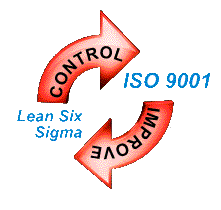 T
The January 2008 ISO TS Network meeting, sponsored by the Kent State University Trumbull Campus, featured a talk by John Novak from KAVON International, Inc. who is a Certified Lean Six Sigma Master Black Belt. Johnís topic was titled
"Deploying a Lean Six Sigma Continual Improvement Program within ISO 9001."
ISO 9001:2000 along with the other Quality Management System Standards require that a company continually improve the processes which define their business. One of the tools that many companies use to meet this requirement is Lean Six Sigma. The question is, Where Do We Start? and How Do We Keep It Going?
During the one and a half hour presentation, John began by introducing the concept of a process, which is central to understanding the ISO 9001 standard. He went on to discuss the requirement for continual improvement as defined in the standard and the commitment that needs to be expressed in the Quality Policy. John discussed how the Lean Six Sigma methodologies can be used to fulfill theses requirements.
John described the Lean Six Sigma continual improvement model using a three pronged approach:
 Team Oriented Problem Solving (TOPS)
Team Oriented Problem Solving (TOPS)
TOPS defines the steering committee, which consists of top management individuals. This group approves and selects projects that contribute to the attainment of the organizationís strategic objects. Once a project is selected, this group builds the team to complete the project.
Lean
Lean is the component of the model that looks at a process with the objective of eliminating the waste. Waste is defined as anything the customer is unwilling to pay for. This increases the velocity of the process because the wasteful activities have been eliminated.
Six Sigma
Six Sigma looks at the variation in the process and attempts to identify and reduce it, thus reducing defects. John emphasized that Lean without Six Sigma results in processes that produce defects faster.

After further discussion on the continual improvement model itself, John brought the discussion back to ISO 9001. He indicated that any improvements achieved would be wasted if there wasnít a way to sustain the gains and institutionalize the new process. Thatís where the tools of ISO 9001 come into play.
ISO 9001 requires internal auditing, management reviews, process measurement and corrective and preventive actions. John discussed how these elements of the standard could be used to realize the benefits of the improvements and contribute to increased competitiveness and financial stability.
